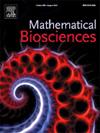A mathematical model of Cheyne-Stokes or periodic breathing
IF 1.9
4区 数学
Q2 BIOLOGY
引用次数: 0
Abstract
Cheyne-Stokes Breathing is a periodic cycle of apnea followed by hyperventilation. A theory of this phenomenon is developed based on a minimal set of physiological assumptions. The rate of loss of CO2 from venous blood is proportional to the CO2 concentration in the lungs times the respiration rate; the respiration rate is a linear function of arterial CO2 concentration above a threshold, and zero below that threshold. A time delay between blood in lungs and respiratory response allows the system to go into oscillation. These assumptions lead to a single nonanalytic delay-differential equation containing only three parameters, which we call respiratory recovery coefficients, . A detailed study of the solutions to this equation is presented here. For below a first threshold, breathing becomes steady, and any disturbance recovers exponentially to the steady state (∼overdamped oscillator). Above the first threshold, breathing recovers to the steady state by decaying oscillations (∼underdamped oscillator). Above a second threshold, oscillations grow to reach a limit cycle, and when that cycle is sufficiently large, it represents the Cheyne-Stokes cycle of hyperventilation and apnea. Fourier analysis shows that the transition to growing oscillations is a forward or soft Hopf bifurcation. In the Cheyne-Stokes region (sufficiently large ), the equation predicts the shapes of the curves representing the time-dependence of arterial CO2 and the respiration rate. From these shapes, we infer the values of the respiratory recovery coefficients for several groups of patients. With additional approximations, we infer the values of other physiological parameters, including cardiac output, CO2 chemosensitivity, and volume of blood between lungs and detectors.
切恩-斯托克斯或周期性呼吸的数学模型。
切恩-斯托克斯呼吸(Cheyne-Stokes Breathing)是一种先呼吸暂停后过度换气的周期性循环。这一现象的理论是基于一系列最基本的生理假设提出的。静脉血中二氧化碳的流失率与肺部二氧化碳浓度乘以呼吸频率成正比;呼吸频率是动脉二氧化碳浓度高于阈值时的线性函数,低于阈值时为零。肺部血液与呼吸反应之间的时间延迟使系统进入振荡状态。这些假设导致了一个单一的非解析延迟微分方程,其中只包含三个参数,我们称之为呼吸恢复系数(α,β,γ)。本文将对该方程的解进行详细研究。当 β 低于第一个临界值时,呼吸变得稳定,任何干扰都会以指数形式恢复到稳定状态(过阻尼振荡器)。超过第一个阈值时,呼吸通过衰减振荡恢复到稳定状态(∼欠阻尼振荡器)。当超过第二个阈值时,振荡增加并达到一个极限周期,当该周期足够大时,它代表了过度换气和呼吸暂停的谢恩-斯托克斯周期。傅立叶分析表明,向振荡增长的过渡是一个前向或软霍普夫分岔。在Cheyne-Stokes区域(β足够大),方程预测了代表动脉二氧化碳和呼吸频率时间依赖性的曲线形状。根据这些形状,我们可以推断出几组患者的呼吸恢复系数值。通过额外的近似值,我们可以推断出其他生理参数的值,包括心输出量、二氧化碳化学敏感性以及肺部和探测器之间的血容量。
本文章由计算机程序翻译,如有差异,请以英文原文为准。
求助全文
约1分钟内获得全文
求助全文
来源期刊

Mathematical Biosciences
生物-生物学
CiteScore
7.50
自引率
2.30%
发文量
67
审稿时长
18 days
期刊介绍:
Mathematical Biosciences publishes work providing new concepts or new understanding of biological systems using mathematical models, or methodological articles likely to find application to multiple biological systems. Papers are expected to present a major research finding of broad significance for the biological sciences, or mathematical biology. Mathematical Biosciences welcomes original research articles, letters, reviews and perspectives.
 求助内容:
求助内容: 应助结果提醒方式:
应助结果提醒方式:


